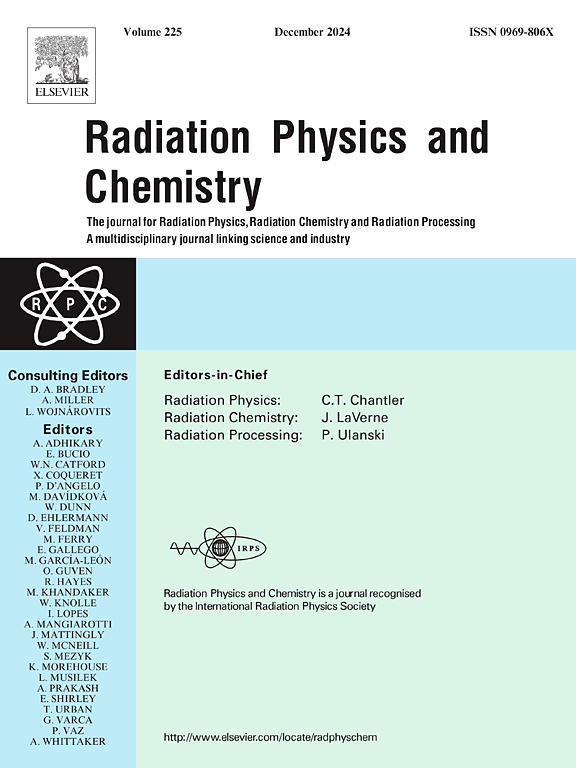Thermoluminescence and optically stimulated luminescence of CaSO4:Mn,Tb with different dopant concentrations
IF 2.8
3区 物理与天体物理
Q3 CHEMISTRY, PHYSICAL
引用次数: 0
Abstract
This study systematically evaluates the thermoluminescence (TL) and optically stimulated luminescence (OSL) properties of CaSO4 crystals doped with manganese (Mn) and terbium (Tb), focusing on dopant concentrations within the ranges of Mn (0.1 mol % – 2 mol %) and Tb (0.05 mol % – 1 mol %). Synthesized via the slow evaporation route, this investigation is part of an ongoing experimental series initiated by Silva et al. (2022), exploring CaSO4:Mn,Tb crystals at a concentration of 0.1 mol %, validating their properties for dosimetric purposes. A structural phase identification was conducted using X-ray diffraction and energy-dispersive spectroscopy (EDS) spectra confirming the presence of Tb3+ and Mn2+ ions in the crystalline matrices. Dosimetric characterization utilized pellets prepared by incorporating Teflon into the phosphors. In-depth investigations involved analyzing TL glow curves and Continuous Wave Optically Stimulated Luminescence (CW-OSL) curves. Observations revealed that TL intensity increased as the co-doped concentration of Tb decreased while maintaining the concentration of Mn constant, in both visible and UV regions. Conversely, at a constant terbium concentration, increasing Mn2+ concentration enhanced the sensitivity of low-temperature TL traps in the visible region. However, at higher Mn concentrations, such as 1 % and 2 %, TL intensity in deeper traps decreased. In the UV region, TL signals remained stable as the concentration of Mn2+ increased from 0.1 % to 0.5 %, with only a slight shift in peak temperatures. Concentrations above 1 % led to a decrease in TL intensity. All samples produced suitable OSL curves. Fixing Mn2+ at 1 mol % and decreasing Tb3+ concentration also resulted in increased OSL signals. The optimal Mn2+ concentration, with Tb3+ fixed at 0.1 mol %, was found to be at 0.1 mol %, where OSL sensitivity was maximized. This research underscores the importance of optimizing dopant concentrations to enhance the potential of these phosphors for precise and reliable dosimetry, thereby advancing both the understanding of these materials and their potential for further development in the field of radiation dosimetry.

不同掺杂浓度的CaSO4:Mn,Tb的热致发光和光激发发光
本研究系统地评价了锰(Mn)和铽(Tb)掺杂的CaSO4晶体的热致发光(TL)和光激发发光(OSL)性能,重点研究了掺杂浓度在Mn (0.1 mol % - 2 mol %)和Tb (0.05 mol % - 1 mol %)范围内。通过缓慢蒸发途径合成,该研究是Silva等人(2022)发起的正在进行的实验系列的一部分,探索浓度为0.1 mol %的CaSO4:Mn,Tb晶体,验证其用于剂量学目的的性质。利用x射线衍射和能谱分析(EDS)进行了结构物相鉴定,证实了晶体中存在Tb3+和Mn2+离子。剂量学表征利用将聚四氟乙烯掺入荧光粉制备的微球。深入研究包括分析TL发光曲线和连续波光激发发光(CW-OSL)曲线。观察发现,在可见光区和紫外区,TL强度随着共掺杂Tb浓度的降低而增加,同时保持Mn浓度不变。相反,在一定的铽浓度下,增加Mn2+浓度可以增强低温TL阱在可见光区的灵敏度。然而,在较高的Mn浓度下,如1%和2%,深阱的TL强度下降。在紫外区,当Mn2+浓度从0.1%增加到0.5%时,TL信号保持稳定,峰值温度只有轻微的变化。浓度大于1%导致TL强度降低。所有样品都产生了合适的OSL曲线。将Mn2+固定在1 mol %,降低Tb3+浓度也会导致OSL信号增加。当Tb3+固定在0.1 mol %时,Mn2+的最佳浓度为0.1 mol %,此时OSL的灵敏度最大。这项研究强调了优化掺杂浓度的重要性,以增强这些荧光粉精确可靠的剂量测定的潜力,从而促进对这些材料的理解及其在辐射剂量测定领域的进一步发展潜力。
本文章由计算机程序翻译,如有差异,请以英文原文为准。
求助全文
约1分钟内获得全文
求助全文
来源期刊

Radiation Physics and Chemistry
化学-核科学技术
CiteScore
5.60
自引率
17.20%
发文量
574
审稿时长
12 weeks
期刊介绍:
Radiation Physics and Chemistry is a multidisciplinary journal that provides a medium for publication of substantial and original papers, reviews, and short communications which focus on research and developments involving ionizing radiation in radiation physics, radiation chemistry and radiation processing.
The journal aims to publish papers with significance to an international audience, containing substantial novelty and scientific impact. The Editors reserve the rights to reject, with or without external review, papers that do not meet these criteria. This could include papers that are very similar to previous publications, only with changed target substrates, employed materials, analyzed sites and experimental methods, report results without presenting new insights and/or hypothesis testing, or do not focus on the radiation effects.
 求助内容:
求助内容: 应助结果提醒方式:
应助结果提醒方式:


